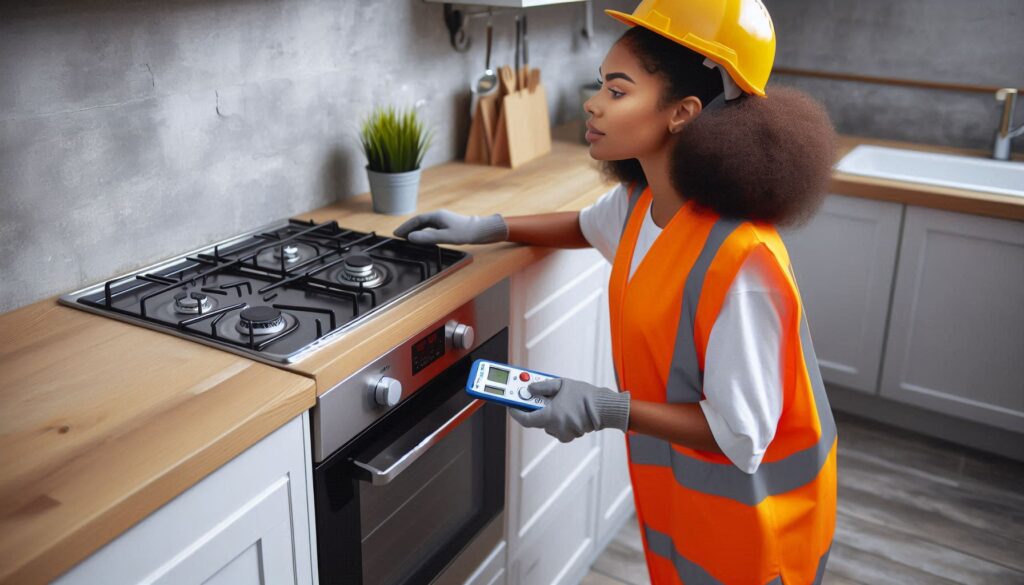
When designing or renovating a kitchen, one of the most overlooked yet critical aspects is proper cooker positioning. In many London homes—especially smaller city flats and compact kitchens—space can be tight, which makes following cooker distance safety standards even more essential. The placement of your cooker impacts not only the functionality of your kitchen but also your home’s kitchen layout compliance with building and safety regulations.
Whether you’re a homeowner, landlord, or tenant, understanding how to position a cooker safely ensures you stay within the law, maintain good ventilation, and reduce fire or accident risks. In this guide, we’ll explore why correct positioning matters, what the official guidelines require, and how to design a safe, efficient, and regulation-compliant kitchen in London.
Cookers are among the most frequently used appliances in any household, yet they’re also one of the most dangerous if improperly installed. Good cooker distance safety helps protect you from common hazards like overheating, gas leaks, or fires caused by proximity to combustible materials.
In London, where many kitchen spaces are smaller or irregularly shaped, ensuring kitchen layout compliance requires professional planning. Local regulations and Gas Safe guidelines dictate how far your cooker should be from walls, windows, and other appliances. Ignoring these standards can lead to overheating, poor ventilation, or even violations of safety codes during property inspections.
Cooker distance safety guidelines exist to ensure safe spacing between your cooker and surrounding elements. In most London installations, cookers should maintain the following clearances:
Adhering to these distances helps prevent overheating and potential fire hazards. These rules are part of kitchen layout compliance standards that every gas engineer or installer must follow during new kitchen builds or remodels in London.
Even experienced homeowners can make positioning errors that compromise safety. Some of the most common mistakes affecting cooker distance safety include:
Such setups fail kitchen layout compliance checks and can lead to excessive heat accumulation or restricted ventilation. In older London homes, cookers are sometimes squeezed into tight alcoves to save space—an unsafe practice that increases fire risks and makes maintenance difficult.
Ventilation plays a major role in cooker distance safety. Without adequate airflow, gas combustion can produce harmful fumes such as carbon monoxide. Proper ventilation ensures that your kitchen remains safe and breathable while cooking.
In London’s high-density housing, ensuring kitchen layout compliance often means adding extractor fans or hoods that meet specific airflow capacity requirements. For gas cookers, the vent should be installed at the correct height and lead directly outdoors to allow effective extraction.
Cooker placement isn’t just about safety—it also affects how efficiently your kitchen operates. Strategic cooker distance safety planning can improve workflow by keeping essential areas, like the sink and fridge, within easy reach.
This is often referred to as the “kitchen work triangle”, an essential concept in kitchen layout compliance. The cooker, sink, and refrigerator should form a triangle that allows smooth movement between tasks. In London’s compact kitchens, achieving this layout requires smart design choices that maintain safety distances while maximizing usability.
A properly positioned cooker ensures even heat distribution and makes cleaning easier. Poor positioning, on the other hand, may cause uneven cooking results, energy waste, or excessive wear on the appliance.

Different fuel types require different approaches to cooker distance safety.
In both cases, maintaining safe distances from combustible materials, proper ventilation, and secure electrical or gas connections is mandatory for compliance and safety.
Landlords across London must take extra care to ensure cooker distance safety in rental properties. For further details on how landlords can ensure full compliance, read our post on cooker installation safety for landlord-owned flats. Under the Gas Safety (Installation and Use) Regulations 1998, landlords are legally responsible for providing safe, compliant gas appliances.
Failure to meet kitchen layout compliance standards can lead to fines, legal penalties, or even invalidated insurance coverage. Regular gas safety checks and professional installation are essential to maintaining compliance.
Landlords should also provide tenants with clear instructions on using and cleaning cookers safely, along with emergency contact numbers for any gas-related incidents.
Here are a few easy-to-follow tips to keep your kitchen both safe and compliant:
Following these steps strengthens cooker distance safety and ensures full kitchen layout compliance with London’s safety regulations.
If you’re unsure whether your kitchen setup is compliant, it’s best to request a professional inspection. A certified engineer can review your current layout and highlight any issues with cooker distance safety.
They’ll measure distances, check ventilation, and ensure your installation aligns with kitchen layout compliance standards. In London, many property owners schedule these checks annually, especially before renting out or selling their homes.
Failing to meet cooker distance safety regulations can have severe consequences. Apart from obvious safety hazards like fire or gas leaks, homeowners may face legal and financial issues. To reduce such risks, review our expert gas leak prevention tips for London landlords. Insurance companies can refuse claims for fire or damage caused by non-compliant installations.
For landlords, breaching kitchen layout compliance laws can lead to enforcement actions, penalties, and reputational damage. Ensuring compliance upfront costs far less than dealing with fines or accidents later.
Proper cooker positioning isn’t just about aesthetics—it’s about safety, compliance, and long-term efficiency. Understanding cooker distance safety and following kitchen layout compliance rules protects your home, your family, and your investment.
Whether you live in a modern London apartment or a traditional terrace house, following these best practices ensures your kitchen remains both functional and safe. Always rely on professional engineers, schedule regular inspections, and never compromise on spacing or ventilation.
When it comes to kitchen safety, prevention is always better than cure. Smart design and correct installation make all the difference.

